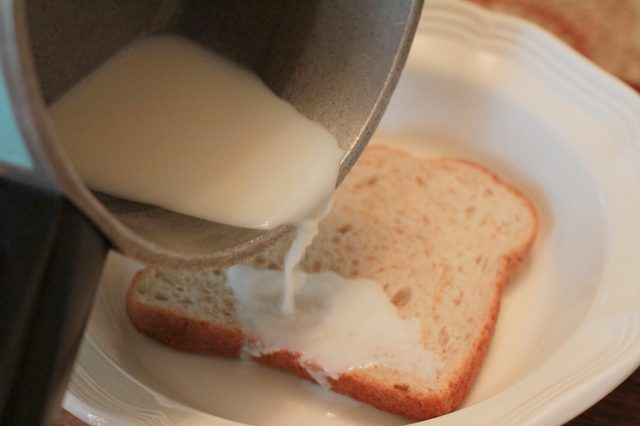Are you looking for a natural remedy to help alleviate pain, reduce inflammation, or draw out toxins from your body? Look no further than a how to make a bread poultice for infected fingers! A poultice is a simple, yet effective, treatment method that has been used for centuries to promote healing and relieve discomfort.
In this article, we will guide you through the process of making a poultice at home using readily available ingredients. Whether you are dealing with a splinter, a bee sting, a bruise, or a skin infection, a poultice can be a valuable addition to your first aid kit.
A poultice is a moist mixture that is applied directly to the skin and then covered with a cloth or bandage. The ingredients used in a poultice can vary depending on the specific condition being treated, but commonly include herbs, plants, clays, or other natural substances with healing properties.
One of the key benefits of using a poultice is its ability to draw out impurities from the body. The moist heat from the poultice helps to increase blood circulation, which in turn promotes healing and reduces swelling. Additionally, the natural ingredients used in a poultice can provide soothing and anti-inflammatory effects.
Throughout this article, we will provide step-by-step instructions on how to make different types of poultices for various conditions. We will also discuss the potential benefits and precautions associated with using poultices as a complementary treatment. So, let’s dive in and learn how to harness the power of poultices for natural healing!
What is a Poultice?
A poultice is a natural remedy that has been used for centuries to treat various ailments and injuries. It is a simple mixture of herbs, plants, or other natural substances that are applied externally to the skin to provide relief and promote healing. Poultices can be made from a wide range of ingredients, including herbs, clays, salts, spices, and even food items.
When applied to the affected area, a poultice works by drawing out toxins, reducing inflammation, increasing blood flow, and providing soothing relief. It is an effective way to treat bruises, sprains, strains, insect bites, stings, boils, abscesses, and other skin conditions. Poultices can also be used to alleviate pain and discomfort caused by arthritis, muscle soreness, and joint inflammation.
The ingredients used in a poultice can vary depending on the specific condition being treated. For example, a poultice for a sprained ankle may include herbs with anti-inflammatory properties, such as arnica and comfrey. On the other hand, a poultice for a bee sting may include ingredients like baking soda or activated charcoal to draw out toxins and reduce swelling.
To make a poultice, the ingredients are typically mixed with a liquid, such as water, vinegar, or oil, to form a paste-like consistency. The paste is then spread onto a clean cloth or directly onto the affected area and covered with a bandage or plastic wrap to keep it in place. The poultice is left on for a specified period of time, usually ranging from 30 minutes to a few hours, before it is removed and the area is rinsed clean.
Poultices are a safe and natural alternative to over-the-counter medications and can be easily made at home using readily available ingredients. However, it is important to note that poultices are not suitable for all conditions, and it is always best to consult with a healthcare professional before using them, especially if you have any underlying health conditions or are taking medications.
Benefits of Using a Poultice
A poultice is a simple yet effective remedy that has been used for centuries to treat various ailments and injuries. Here are some of the key benefits of using a poultice:
1. Natural Healing
Poultices are made from natural ingredients such as herbs, spices, clay, or other plant-based materials. This natural approach to healing is preferred by many as it avoids the use of harsh chemicals or medications that may have unwanted side effects.
2. Reduced Inflammation
Applying a poultice to an inflamed area can help reduce swelling and inflammation. The combination of herbs and other ingredients in the poultice works to soothe the affected area and promote healing.
3. Pain Relief
Poultices can provide effective pain relief for a variety of conditions, including sprains, bruises, muscle aches, and joint pain. The ingredients in the poultice help to alleviate discomfort and promote relaxation in the affected area.
4. Improved Circulation
When applied to the skin, poultices can help improve blood circulation in the affected area. This increased blood flow can aid in the delivery of oxygen and nutrients to the tissues, promoting faster healing and recovery.
5. Drawing Out Toxins
Poultices are often used to draw out toxins or impurities from the body. The ingredients in the poultice can help to detoxify the skin and underlying tissues, aiding in the removal of harmful substances.
6. Wound Healing
Poultices can be used to promote the healing of wounds, cuts, and abrasions. The natural ingredients in the poultice help to cleanse the wound, prevent infection, and stimulate the growth of new skin cells.
7. Versatility
Poultices can be customized to address specific conditions or ailments. Different combinations of herbs, spices, or other ingredients can be used to target different issues, making poultices a versatile treatment option.
8. Cost-Effective
Making a poultice at home using readily available ingredients is a cost-effective alternative to purchasing expensive over-the-counter medications or treatments.
In conclusion, poultices offer a range of benefits including natural healing, reduced inflammation, pain relief, improved circulation, toxin removal, wound healing, versatility, and cost-effectiveness. Incorporating poultices into your healthcare routine can provide a holistic and effective approach to managing various ailments and injuries.
Types of Poultices
1. Herbal Poultice
An herbal poultice is a type of poultice that is made using various herbs and plant materials. These poultices are known for their therapeutic properties and have been use for centuries to treat various ailments.
To make an herbal poultice, you can start by selecting the appropriate herbs based on the desired effect. Common herbs used in herbal poultices include chamomile, lavender, calendula, and comfrey. These herbs can be either fresh or dried.
Next, you will need to prepare the herbs by grinding them into a fine powder or mashing them into a paste. You can use a mortar and pestle or a blender for this process. Once the herbs are prepare, mix them with a suitable base such as water, oil, or honey to create a paste-like consistency.
Apply the herbal poultice directly to the affected area and cover it with a clean cloth or bandage. Leave it on for a specified period, usually around 20-30 minutes, and then remove it. Repeat the process as needed.
2. Clay Poultice
A clay poultice is a type of poultice that uses clay as the main ingredient. It is commonly use to draw out toxins, reduce inflammation, and promote healing.
To make a clay poultice, you will need to select the right type of clay. Bentonite clay and French green clay are popular choices due to their detoxifying and healing properties.
In a bowl, mix the clay powder with water or apple cider vinegar until you achieve a smooth, paste-like consistency. Apply the clay poultice directly to the affected area, ensuring it covers the entire area. Cover it with a clean cloth or plastic wrap to prevent it from drying out quickly.
Leave the clay poultice on for about 20-30 minutes, or until it dries. Then, gently remove the poultice and rinse the area with warm water. Repeat the process as needed.
3. Bread Poultice
How to make a bread poultice for infect fingers is a simple and effective type of poultice that can be made using basic household ingredients. It is commonly use to treat skin infections, boils, and abscesses.
To make a bread poultice, start by soaking a slice of bread in warm water or milk until it becomes soft. Once the bread is soft, remove any excess liquid and place it on a clean cloth or bandage. If you need help, here is a great guide on how to make a bread poultice for infected fingers, and other maladies.
Apply the bread poultice directly to the affected area, ensuring it covers the entire area. Secure it in place with a bandage or tape. Leave it on for a few hours or overnight.
When it’s time to remove the poultice, gently lift it off the skin and discard it. Cleanse the area with warm water and apply a suitable antibacterial ointment if necessary. Repeat the process as needed.
4. Salt Poultice
A salt poultice is a type of poultice that uses salt as the main ingredient. It is commonly use to draw out infections, reduce inflammation, and relieve pain.
To make a salt poultice, you will need to mix salt with a small amount of water to form a thick paste. You can use either table salt or Epsom salt for this poultice.
Apply the salt poultice directly to the affected area, ensuring it covers the entire area. Cover it with a clean cloth or bandage to keep it in place. Leave it on for about 20-30 minutes.
After the recommended time, gently remove the poultice and rinse the area with warm water. Repeat the process as needed.
Gather the Ingredients
Before you start making a poultice, gather all the necessary ingredients. Here’s what you’ll need:
Base ingredient: Choose a suitable base ingredient such as clay, activated charcoal, bread, or flaxseed meal. The base ingredient helps hold the poultice together and provides a medium for the active ingredients to work.
Active ingredients: Depending on the purpose of the poultice, you may need herbs, essential oils, or other natural substances. Research the specific condition you’re addressing to determine the most effective active ingredients.
Liquid: You’ll need a liquid to moisten the base ingredient and create the right consistency. Water, herbal infusions, or apple cider vinegar are common choices.
Bowl and spoon: Use a non-reactive bowl and spoon for mixing the ingredients. Avoid metal utensils, as they can react with certain substances.
Cloth or bandage: Prepare a clean cloth or bandage to cover the poultice once applied.
Prepare the Poultice Base
Start by preparing the base ingredient for your poultice:
Clay: If using clay, mix the appropriate amount with water or herbal infusion until you achieve a thick, spreadable consistency.
Activated charcoal: For activated charcoal, combine it with a small amount of water to form a paste.
Bread or flaxseed meal: When using bread or flaxseed meal, dampen it with water or herbal infusion to create a moldable texture.
Note: Adjust the quantities of the base ingredient and liquid as need to achieve the desire consistency.
Add the Active Ingredients
Once you have prepared the base, it’s time to incorporate the active ingredients:
Herbs or essential oils: Measure the recommended amount of herbs or essential oils and mix them into the base ingredient. Ensure they are evenly distribute.
Other natural substances: If using other natural substances, follow the specific instructions for their incorporation. Some may require heating or additional preparation steps.
Mix and Apply the Poultice
Follow these steps to complete your poultice:
Mix: Thoroughly mix all the ingredients until they are well combine.
Apply: Spread the poultice mixture onto the cloth or bandage, ensuring it covers the affected area completely. The poultice should be about ¼ to ½ inch thick.
Cover: Place the cloth or bandage with the poultice onto the affected area and secure it in place.
Leave on: Let the poultice sit for the recommended duration, typically 30 minutes to a few hours, depending on the condition being address.
Remove: After the recommended time, carefully remove the poultice and discard it.
Cleanse: Cleanse the area with warm water and pat dry.
Remember, it’s important to consult with a healthcare professional or do thorough research before using a poultice to ensure it is appropriate for your specific condition.
Common Uses of Poultices
Poultices have been use for centuries as a natural remedy for various ailments and injuries. Here are some common uses of poultices:
1. Drawing out Infections
Poultices are often used to draw out infections and promote healing. They can be applied to abscesses, boils, or wounds to help reduce inflammation and speed up the healing process. The natural ingredients in poultices, such as herbs or clay, have properties that help to draw out toxins and impurities from the affected area.
2. Relieving Inflammation
Poultices can be beneficial in reducing inflammation caused by conditions such as arthritis, sprains, or strains. The application of a poultice helps to soothe the affected area and provide relief from pain and swelling. Ingredients like turmeric, ginger, or chamomile possess anti-inflammatory properties that can help alleviate discomfort.
3. Treating Skin Conditions
Poultices can be used to treat various skin conditions, including eczema, psoriasis, or insect bites. The natural ingredients in poultices can help soothe itching, reduce redness, and promote healing. Ingredients like aloe vera, calendula, or oatmeal are commonly used in poultices for their skin-soothing properties.
4. Relieving Congestion
Poultices can be applied to the chest or sinuses to help relieve congestion caused by colds, flu, or respiratory infections. Ingredients like eucalyptus, peppermint, or mustard have decongestant properties that can help clear the airways and promote easier breathing.
5. Healing Wounds
Poultices can aid in the healing process of wounds, cuts, or bruises. They provide a moist environment that helps prevent infection and promotes faster healing. Ingredients like honey, lavender, or comfrey are often use in poultices for their antimicrobial and wound-healing properties.
6. Alleviating Pain
Poultices can be use topically to alleviate pain cause by conditions such as muscle aches, joint pain, or headaches. Ingredients like cayenne pepper, arnica, or menthol have analgesic properties that can help reduce pain and provide temporary relief.
Remember to consult with a healthcare professional or herbalist before using poultices for any specific condition, especially if you have allergies or sensitivities to certain ingredients.
Precautions and Tips
When making and using a poultice, it is important to keep in mind the following precautions and tips:
1. Safety First
Always prioritize safety when handling and preparing ingredients for your poultice. Wear gloves and protective clothing to prevent any adverse reactions or skin irritations.
2. Cleanliness
Ensure that all the tools, containers, and surfaces you use are clean and sanitized. This helps prevent contamination and the introduction of unwanted bacteria into the poultice.
3. Allergies and Sensitivities
Be aware of any allergies or sensitivities you or the intended recipient may have to specific ingredients. Avoid using ingredients that may trigger an allergic reaction or worsen existing skin conditions.
4. Patch Test
Before applying the poultice to a larger area, perform a patch test on a small, inconspicuous area of the skin. This will help determine if any adverse reactions or sensitivities may occur.
5. Consistency
Ensure that the poultice has the right consistency. It should be spreadable but not too runny. Adjust the amount of liquid or dry ingredients accordingly to achieve the desired consistency.
6. Application Time
Follow the recommended application time for the specific condition you are treating. Leaving the poultice on for too long or too short of a duration may not yield the desired results.
7. Storage
If you need to store the poultice for future use, ensure it is properly sealed and stored in a cool, dry place. Check for any signs of spoilage or changes in texture before using it again.
8. Consultation
If you have any underlying health conditions or concerns, it is advisable to consult with a healthcare professional before using a poultice. They can provide guidance specific to your situation.
9. Discontinue Use
If you experience any unexpected or adverse reactions while using a poultice, discontinue use how to make a bread poultice for infected fingers immediately. Seek medical advice if necessary.
By following these precautions and tips, you can safely and effectively make and use poultices for various ailments and conditions.
Conclusion
In conclusion, making a poultice is a simple and effective way to treat various ailments and injuries. By following the step-by-step instructions provided in this article, you can create a poultice using readily available ingredients from your kitchen or local store.
The versatility of poultices makes them a valuable addition to your natural remedy toolkit. Whether you’re dealing with a sprained ankle, a splinter, a bee sting, or even a stubborn pimple, poultices can provide relief and promote healing.
Remember to choose the right ingredients based on the specific condition you’re treating. For inflammation and swelling, opt for anti-inflammatory herbs like turmeric or chamomile. For drawing out toxins or infections, activated charcoal or Epsom salt can be beneficial.
It’s important to note that while poultices can be effective, they should not replace professional medical advice. If you have a severe injury or a chronic condition, it’s always best to consult with a healthcare professional.
Lastly, don’t forget to properly clean and disinfect the affected area before applying the poultice. This will help prevent any further infection and ensure the poultice can work its magic.
So, the next time you find yourself in need of a natural remedy, consider making a poultice. With its simplicity, affordability, and potential healing properties, it’s a wonderful option for anyone looking to take a more holistic approach to their health.
References
1. “The Poultice: Definition and Uses.” WebMD, WebMD, www.webmd.com/drugs/2/drug-148118/poultice/details.
This informative article from WebMD provides a comprehensive definition of poultices and explores their various uses. It offers valuable insights into the benefits and applications of poultices, making it a reliable source for understanding the topic.
2. “Herbal Poultices: How to Make and Use Them.” Herbal Academy, www.herbalacademyofne.com/2018/06/herbal-poultices-how-to-make-and-use-them/.
The Herbal Academy offers a detailed guide on making and using herbal poultices. This resource covers different types of poultices, the necessary ingredients, and step-by-step instructions for preparation and application. It is a helpful reference for those interested in exploring herbal remedies.
3. “How to Make a Poultice: An Easy Guide.” Healthline, Healthline Media, www.healthline.com/health/how-to-make-a-poultice#making-a-poultice.
Healthline provides a step-by-step guide on making poultices, including tips on selecting the right ingredients and preparing the mixture. The article also discusses various types of poultices and their potential benefits. It is a valuable resource for anyone looking to create their own poultices at home.
4. “Poultices: How to Make and Use Them.” Medical News Today, MediLexicon International, www.medicalnewstoday.com/articles/323968#how-to-make-a-poultice.
This article from Medical News Today offers a comprehensive overview of poultices, including detailed instructions on making and using them effectively. It also explores the potential benefits and risks associated with poultice application. The information provided is reliable and trustworthy.
5. “Poultice.” Wikipedia, Wikimedia Foundation, 19 Oct. 2021, en.wikipedia.org/wiki/Poultice.
Wikipedia provides a general overview of poultices, covering their history, uses, and application methods. While it is always advisable to cross-reference information from other sources, Wikipedia can be a good starting point for obtaining a basic understanding of the topic.
6. “The Benefits of Using a Poultice for Inflammation and Wound Healing.” Verywell Health, Dotdash, www.verywellhealth.com/what-is-a-poultice-4582077.
This article by Verywell Health discusses the benefits of using poultices for inflammation and wound healing. It delves into the science behind poultices and their potential effectiveness. The information provide is well-research and can be useful for those seeking natural remedies.
7. “How to Make a Poultice for Boils, Infections, or Wounds.” Healthline, Healthline Media, www.healthline.com/health/how-to-make-a-poultice-for-boils-infections-wounds.
Healthline offers a specific guide on making poultices for boils, infections, and wounds. The article provides detailed instructions, along with information on the ingredients and their potential benefits. It is a reliable source for individuals looking for targeted poultice recipes.
8. “Poultices and Compresses.” University of Maryland Medical Center, www.umm.edu/health/medical/altmed/treatment/poultices-and-compresses.
The University of Maryland Medical Center provides an overview of poultices and compresses as alternative treatments. It discusses their potential benefits, uses, and safety considerations. This resource is particularly useful for those seeking a scientific perspective on poultice application.
How to Make Poultices to Cure Maladies







